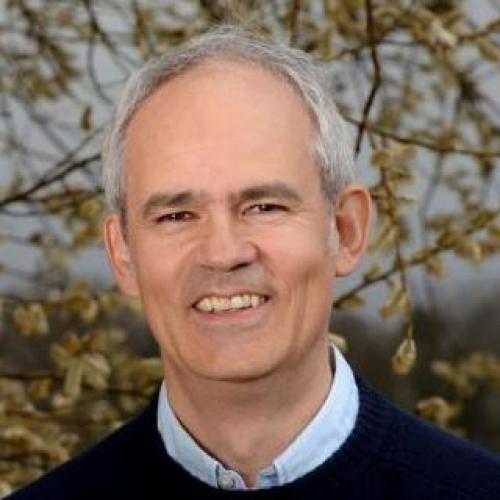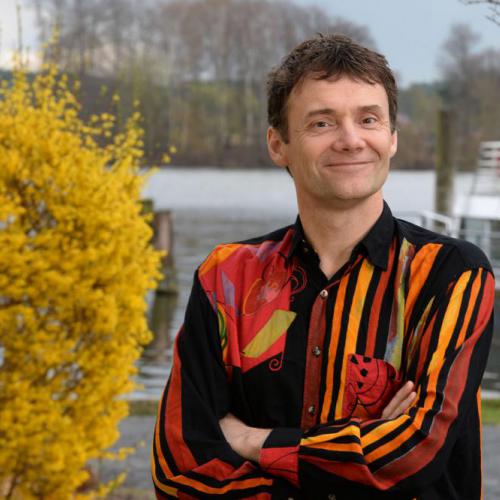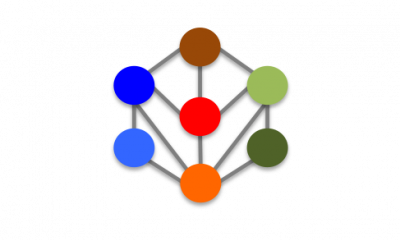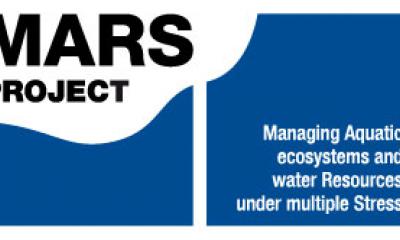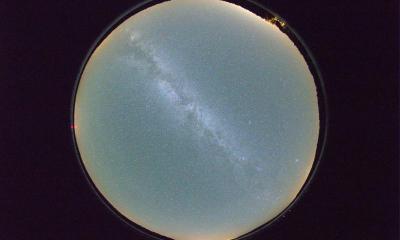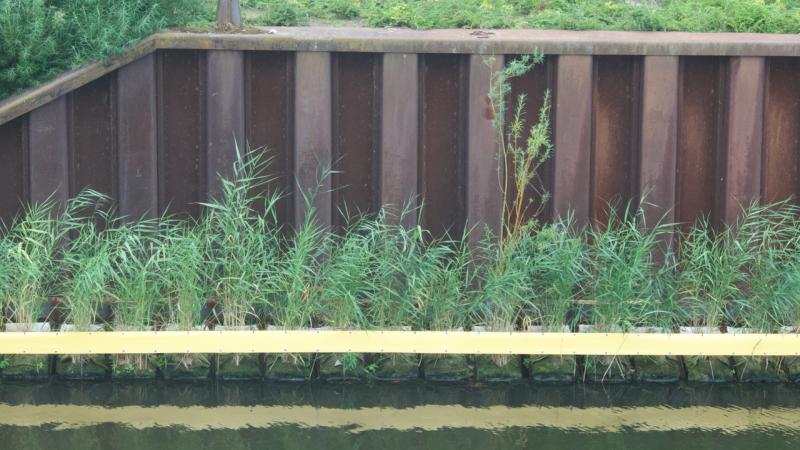
The LakeLab consists of a large central enclosure (30 m in diameter) and 24 enclosures of identical construction (9 m in diameter). These smaller enclosures serve as the experimental units. | Photo: Andreas Jechow
Mr Gessner, you have been leading IGB’s department at Lake Stechlin since 2011, i.e. you started work there shortly before the LakeLab was constructed. You oversaw the application, planning and implementation phases. A massive undertaking for you to kick off with, was it not?
Yes, it was indeed a flying start, but looking back, also a very encouraging one. After all, the idea of installing a large experimental facility in Lake Stechlin was one of the reasons why I left Eawag, the Swiss national aquatic research institute, to come to Germany. Using such a facility to answer important and interesting research questions was truly a very exciting task. The German Federal Ministry of Education and Research (BMBF) recognised the importance of the idea, and went on to fund the construction of the LakeLab.
What was the greatest challenge at the beginning?
A particular challenge, once our application had been approved, was the tight timeline. Within the space of just over six months, we had to design the technology of the LakeLab, organise the Europe-wide tender, and construct the facility. It was only possible thanks to streamlined cooperation between the BMBF, the executing agency, the Forschungsverbund Berlin, the companies we commissioned, most notably AGO in Berlin, and those involved at IGB. Another major task was to convince all local stakeholders in government and society of the importance of the LakeLab. It took a lot of communication, but we always took a very open approach. It was time-consuming. But I believe that our efforts have helped to put IGB firmly on the regional map, although there was staunch opposition to the LakeLab, particularly from some conservation groups.
You mentioned opposition to the LakeLab. What were the concerns?
Lake Stechlin is one of Germany’s prettiest clearwater lakes. Many of the initial fears were prompted by concerns about the lake. For a start, there were aesthetic concerns: what effect would such an outdoor facility have on recreation-seekers, for example? And then there were worries that experiments in the LakeLab could have a negative impact on Lake Stechlin. Of course those fears had to be allayed. This is why every single one of our projects has to be approved by the authorities in the district. In other words, in addition to our own ethical standards, an independent body thoroughly reviews all of our proposed experiments in advance. Nature conservation associations are also included in the process. Moreover, general monitoring measures and further conditions were established to ensure continuous observation of the development of the lake in the immediate vicinity of the LakeLab.
And what about the aesthetic concerns?
Interestingly, we received a lot of positive feedback from the very beginning, despite a few negative voices. We experience this, for example, at events such as our Open Day, which we hold every two years. Aesthetic concerns are rarely raised. In fact, some visitors go on holiday to Lake Stechlin simply to see the LakeLab. That could have something to do with its slightly futuristic design, although this is only visible from aerial photos and not from the shore or on the lake itself. A more probable reason for the positive feedback is the fact that the facility is just barely above the lake surface. Originally, 4-metre high superstructures were envisaged. Today’s LakeLab is nothing like that. Nonetheless, I fully understand those who think it not ideal to have a technical facility in a natural landscape such as the Lake Stechlin region. After all, the LakeLab is not a work of art like the Floating Piers installation created by Christo and his wife in Lake Iseo (Northern Italy) a few years ago.
Why is this research on “lakes within a lake” needed?
We want to understand how lake ecosystems work – enabling us to learn fundamental facts about nature and to manage lakes efficiently. To do this, we need to shed light on the relationships between cause and effect, and this is best done in controlled experiments. That said, we must select experimental conditions that reflect reality. This is not a trivial matter. After all, our object of study is the entire lake ecosystem, with its complex interactions. We are unable to adequately account for such complexity in the test tube or in small-scale laboratory experiments, which is exactly what experiments in the LakeLab can do. And at the same time, such experiments enable us to apply the rules of modern experimental design. This is usually impossible in lake experiments, which are better able to reproduce reality. So the LakeLab manages the balancing act between a high degree of realism and stringent experimental conditions.
Perhaps you could explain these advantages with an example…
In one experiment, we studied the effects of storm events on the plankton community in lakes. To do this, we simulated a summer storm in the LakeLab. The upper water column was mixed at a depth of 7 to 14 metres, very similar to a storm event we observed in Lake Stechlin in 2012. Such deep mixing during the summer stratification phase led to a massive blue-green algal bloom several weeks after the simulated storm, long after normal physical stratification conditions had been restored. As a result, we were able to prove beyond doubt the causal link between summer storms and the development of potentially toxic blue-green algae, paradoxically in a relatively nutrient-poor lake.
To what extent are findings from the LakeLab relevant for lake management or preventive measures?
The example of summer storms clearly shows that, in view of climate change, we must also worry about clear lakes, which so far have had no problems with algal blooms. And in general we must assume that, besides several other changes, eutrophication phenomena will increasingly occur in lakes in the future, even in the absence of excessive nutrients. This means that we need to step up efforts to reduce nutrient inputs if we are to maintain the improvements in lake conditions that have been achieved in recent decades.
Looking to the future, where will the LakeLab be in 10 years’ time, what are the next big ideas?
One aspect that we had not even considered initially is the use of remote sensing to analyse lakes. The LakeLab is an ideal calibration instrument for this purpose. This is because we can set different conditions in the various experimental units, and especially gradients of algal biomass or concentrations of humic substances, which we can characterise on site using traditional and innovative methods, and then compare with aerial and satellite images. I would also like to study the effects of global warming on the lake ecosystem. Although there are already a vast number of studies on this, virtually no experiments take into account the complexity of lakes whilst complying with the rules of modern experimental design.
One last sentence about the LakeLab
20 nations from all continents of the world gathered together in a small village with fewer than 300 inhabitants – this is also a result of the LakeLab. This facility has made Lake Stechlin an increasingly important research location for people from all over the world. The EU infrastructure projects AQUACOSM and AQUACOSM-plus, coordinated by Jens Nejstgaard and Stella Berger, have generated enormous international visibility for the LakeLab. It is great to see that the threads of a unique large international network in aquatic research now converge at the LakeLab, 10 years after it was built.
Mr Gessner, thank you for the interview.
The interview was conducted by Nadja Neumann.


